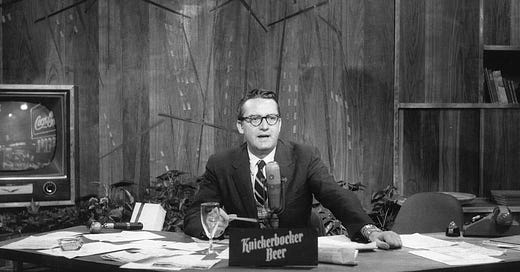Steve Allen: Television’s Jazz Revolutionary
A Love Letter to Late Night's First Mad Genius
By 1954, late-night television was a wasteland of B-movie reruns and test patterns. Then Steve Allen walked onto the set of *The Tonight Show* with a plan: turn America's newest mass medium into jazz's secret weapon.
Most TV hosts could barely hum a tune. Allen had already composed over 4,000 songs, including "This Could Be the Start of Something Big" and "Impossible"—standards that Sinatra would later record. He played piano with the intensity of a man possessed, wrote comedy that bent reality, and somehow convinced NBC to let him do it all on national television.
While other hosts booked novelty acts and safe entertainment, Allen had a different agenda. He wanted to slip jazz—America's most challenging, most black, most intellectual music—into suburban living rooms across the country.
On November 17, 1955, Allen did something unprecedented: he brought Miles Davis's quintet onto network television. Not for a sanitized three-minute number, but for a full performance of "Max is Makin’ Wax” and “It Never Entered My Mind"—seven minutes of modal exploration that sounded like transmission from another planet.
No backup singers. No choreography. No explanation or apology. Just Miles, with John Coltrane on tenor sax, introducing Middle America to the future of music.
The performance was revolutionary precisely because Allen treated it as normal. He didn't announce it with nervous jokes or cultural disclaimers. He presented Miles Davis the same way Ed Sullivan would later present the Beatles—as if sophisticated art belonged on television.
In 1956, Allen took an even bolder step. He moved cameras into Birdland, the legendary jazz club in Manhattan, broadcasting live from the smoky basement where Charlie Parker had redefined American music.
The logistics were nightmare. Television cameras in 1956 were refrigerator-sized monsters requiring massive lighting rigs. Audio equipment was primitive. But Allen wanted authenticity over convenience. He understood that jazz needed its natural habitat—the close quarters, dim lighting, and reverent attention of a real club.
That broadcast brought Count Basie's orchestra, in full swing, directly into America's homes. For viewers in Kansas and Ohio, it was their first glimpse into a world where music could be intellectually demanding and emotionally overwhelming simultaneously.
Skitch Henderson led the original Tonight Show band, but afterwards, on Allen’s other talk shows, Terry Gibbs got the gig. Allen assembled the Terry Gibbs Big Band as his house orchestra—not the usual collection of studio musicians playing jingles, but serious jazz artists led by vibraphone virtuoso Gibbs. They played actual arrangements, took real solos, and swung with the kind of precision that made other TV bands sound like elevator music.
During commercial breaks, instead of canned music, viewers heard bebop. When guests walked on stage, they entered to music that could have been played at the Village Vanguard. Allen often joined on piano, grinning as he comp'd behind Gibbs's mallets or traded fours with the horn section.
Allen's approach worked because he understood television's power to normalize. By presenting jazz as entertainment rather than education, he made it accessible without dumbing it down. Teenagers watching *The Tonight Show* absorbed Thelonious Monk's angular harmonies and Dizzy Gillespie's virtuosic scat singing as part of their regular media diet.
The show's influence extended beyond music. Allen regularly featured black artists during an era when most television remained effectively segregated. He gave airtime to Lenny Bruce's controversial comedy and Jack Kerouac's stream-of-consciousness poetry. His comedy sketches—including his famous phone book reading—pushed absurdism into mainstream entertainment decades before *Saturday Night Live*.
When Allen left *The Tonight Show* in January 1957, the cultural window began closing. His replacements Jack Paar and Johnny Carson were skilled entertainers, but they treated television as entertainment rather than cultural mission. Jazz retreated to late-night slots and educational programming. The mainstream and the avant-garde separated again.
But the impact persisted. Musicians who appeared on Allen's show reached audiences they never could have found otherwise. Viewers who discovered jazz on late-night television became lifelong fans. Television writers absorbed Allen's experimental spirit and carried it into future shows.
Steve Allen proved that mass media could elevate rather than eliminate culture. At a time when television was finding its voice, he insisted that voice could be sophisticated, challenging, and inclusive. He didn't wait for audiences to develop taste—he trusted they already had it.
Today, when jazz appears on television, it's usually in documentary form or educational programming. The idea of a network talk show featuring ten-minute Miles Davis performances seems impossible. But Allen showed it wasn't just possible—it was profitable, popular, and transformative.
He understood something that television executives still struggle with: audiences will embrace challenging art if you present it with confidence rather than apology. You don't need to explain why jazz matters. You just need to let it play.
In an industry built on focus groups and safe choices, Allen made a radical bet: that America was smarter and more curious than anyone assumed. He was right.
The revolution was televised. Steve Allen was holding the camera.
Miles Davis Quintet with John Coltrane, The Tonight Show with Steve Allen
Hudson Theater, New York City, NY, November 17, 1955
Terry Gibbs Remembers Steve Allen
Steve Allen with Count Basie Live at Birdland - July 22, 1956
_ _ _ _ _
Until we meet again, let your conscience be your guide.






Oh yeah!! About time to be reminded of Steve Allen! Bravo, brother Bret! 👍🏻😘❣️
Beautiful story! so well written; I’m learning new info even though I had seen some Allen footage in the past, always glad to get hip to more cool jazz history.